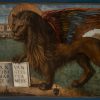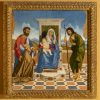Works on display:
Vittore Carpaccio (1460/65-1525/26)
Lion of Saint Mark, 1516
Oil and tempera on canvas
The large canvas by Vittore Carpaccio depicts the typical iconography of the winged lion, symbol of Saint Mark and, by extension, of the Serenissima. The lion is represented while moving, with its hind legs on the lagoon and its front legs on the mainland: a clear reference to the extension of the Venetian empire, divided into “state of land, state of sea”. In the background we can see a view of Venice. On the left are the symbolic places of the Venetian power: the Basilica of San Marco, the façade of the Palazzo Ducale and the newly built Clock Tower; on the right is a view from the Arsenale to today’s Punta della Dogana. The Venetian merchant and military fleet sails in San Marco basin, protected by the Lion’s wing. Carpaccio’s work therefore represents the triumph of the Republic of Venice, which strides on land. The word pax, written in the book and referring to Saint Mark (“Peace to you, Mark, my Evangelist”), also acquires the value of a wish for peace and prosperity addressed to the Serenissima. The painting was probably created for five magistrates of the “Dazio del Vin”, whose coats of arms appear on the lower margin of the canvas. From their offices, the painting was then transferred to the Palazzo dei Camerlenghi di Comun in Rialto and finally, after the fall of the Republic (1797), it became part of the collections of Palazzo Ducale.
*Vincenzo Catena (ca. 1470-1531)
Virgin and Child between Saint Mark, Saint John the Baptist and the Doge Leonardo Loredan, 1505-1507
Oil on panel
The altarpiece was commissioned by Doge Leonardo Loredan (1501-1521) whom we see depicted on his knees, at the foot of the throne with the Virgin and Child. Behind him, there is Saint Mark who presents him to the holy family and on the right Saint John the Baptist, observing the scene. The work, signed, adheres to the model of the devotional paintings of the doges at Palazzo Ducale and must have initially been placed on the altar of the Church in the Palace, when it occupied the space corresponding to today’s Antichurch. At the end of the sixteenth century, the altarpiece was moved above the entrance door of the current church.
* Currently not on view

